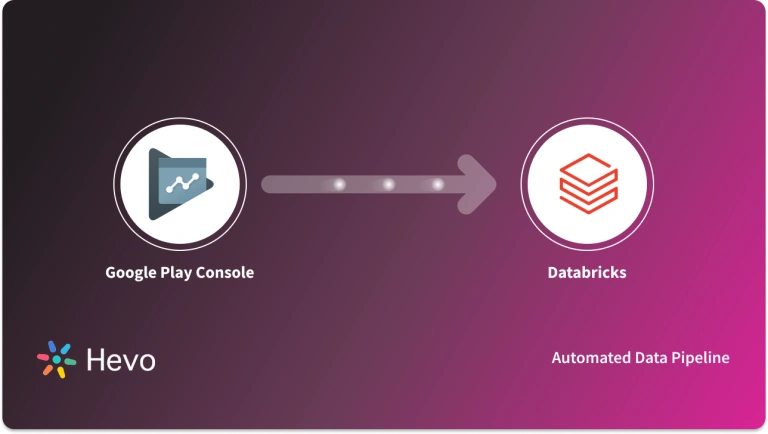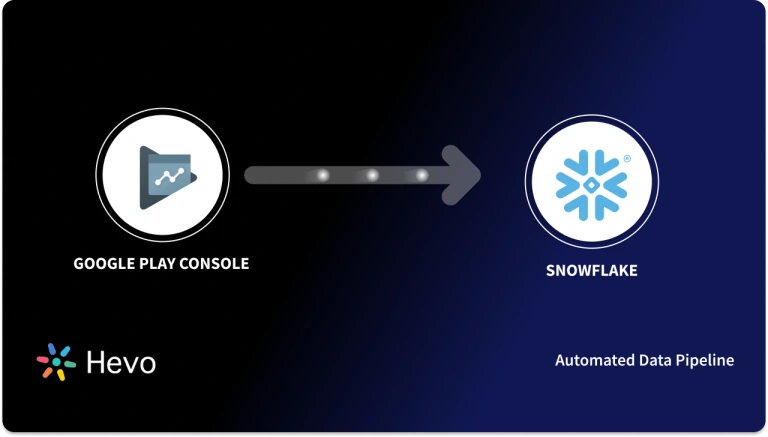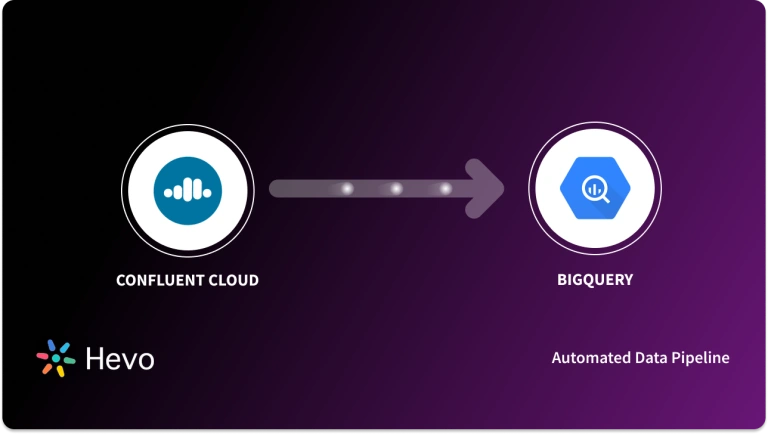Google Play Console and BigQuery are two powerful tools, organizations use together to achieve great results. You can connect Google Play Console to BigQuery, which allows you to centralize your app data for in-depth insights across teams. This enables teams within organizations to work together and make necessary changes based on the issues identified from the application data. Since Alphabet offers both Google Play Console and BigQuery, it makes it seamless to integrate the platforms.
This blog outlines the steps needed to set up Google Play Console BigQuery integration. It also gives a brief introduction to Google Play Console and BigQuery.
Table of Contents
Overview of Google Play Console
The Google Play Console is a platform for app developers to publish apps and track their status. Sellers can add multiple apps to a single product listing and customize the product prices, pages, and distribution. Android vitals, release management, user acquisition, user feedback, financial reporting, and store presence are critical elements of the Google Play Console. You can monitor all aspects of publication on Google Play Store using the Developer Console from your web browser.
Google Play Console gives you access to daily and aggregated reports for your Google Play Store-hosted apps.
- It provides detailed reports of financial data, app ratings, and subscriptions.
- User acquisition and app information are also compiled into reports, such as the number of installs and crashes and user ratings.
Overview of BigQuery
BigQuery is Google’s cloud data warehouse that primarily serves business agility in running complex SQL queries and performing analysis on huge datasets efficiently. It is based on Google technology called Dremel, which uses columnar storage and tree architecture to support high-speed data scanning for querying efficiency.
Facing challenges migrating your customer and product data from Google Play Console into BigQuery? Migrating your data can become seamless with Hevo’s no-code intuitive platform. With Hevo, you can:
- Automate Data Extraction: Effortlessly pull data from Google Play Console(and other 60+ free sources).
- Transform Data effortlessly: Use Hevo’s drag-and-drop feature to transform data with just a few clicks.
- Seamless Data Loading: Quickly load your transformed data into your desired destinations, such as Google BigQuery.
Try Hevo and join a growing community of 2000+ data professionals who rely on us for seamless and efficient migrations.
Get Started with Hevo for FreeMethod 1: Using an Automated Data Pipeline to Set Up Google Play Console BigQuery Integration
Step 1.1: Configure Google Play Console As Your Source

Step 1.2: Configure BigQuery As Your Destination
With this, you have successfully set up Google Play Console BigQuery Integration using Hevo Data.
You can also take a look at how you can integrate your Google Play Console data into Databricks in the same way.
Method 2: Using Custom Code to Move Data from Google Play Console into BigQuery
You can export two types of reports: Detailed reports and Aggregated reports.
2.1) Download Reports from Google Play Console
- Step 2.1.1: Open Google Play Console.

- Step 2.1.2: Click Download Reports, and select from Statistics, Financial, or Reviews.
- Step 2.1.3: Under “Select an application,” find your app’s name.
- Step 2.1.4: Select the year and month of the report you want to download.
2.2) Upload Reports to BigQuery
To import Play Console reports into BigQuery, you must convert the CSV files from UTF-16 to UTF-8. Batch-loading jobs are the best option when uploading local files to BigQuery, primarily if it supports your file format. This method supports the following file formats:
- Avro
- Comma-separated values (CSV)
- JSON (newline-delimited)
- ORC
- Parquet
- Firestore exports stored in Cloud Storage.
Follow these steps to import Play Console data to BigQuery:
- Step 2.2.1: Navigate to the BigQuery home page and select Upload under the Create Table section.
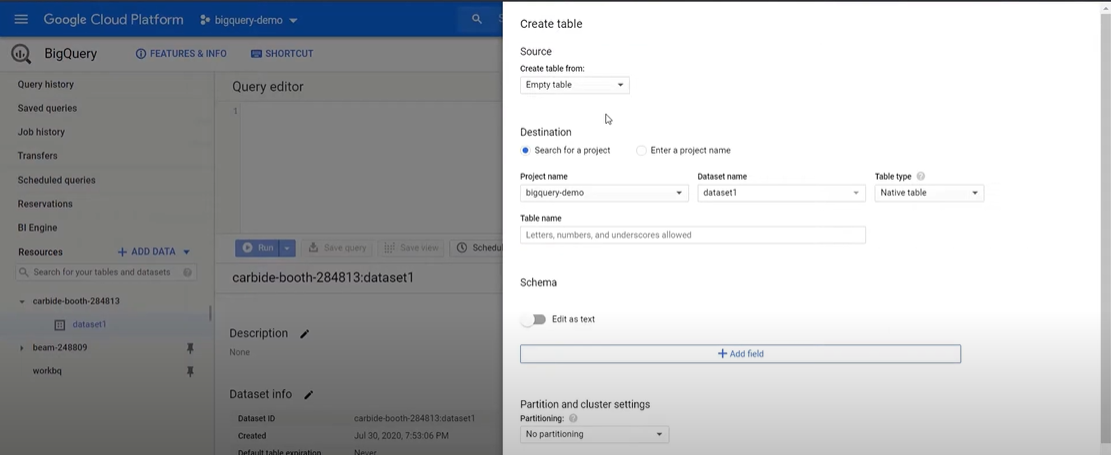
- Step 2.2.2: Select the file and file format. Enter your project name and dataset name under ‘Destination.’
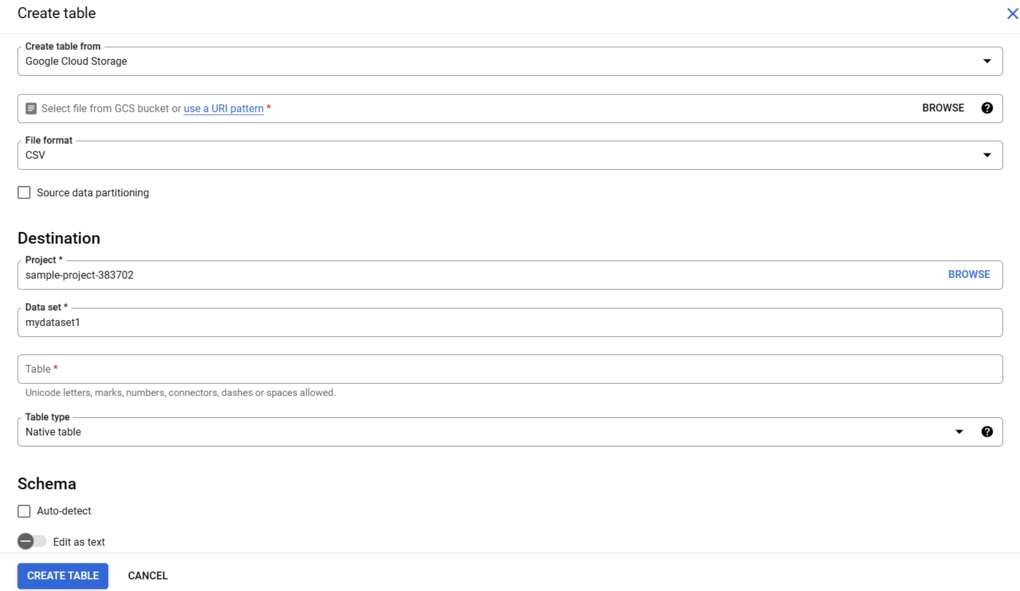
- Step 2.2.3: BigQuery will now automatically determine your table structure.
Method 3: Using BigQuery Data Transfer Service to Connect Google Play Console with BigQuery
For Google Play, BigQuery Data Transfer Service supports reviews and financial reports under detailed reports and statistics and user acquisition under aggregated reports.
Step 3.1: Enable the BigQuery Data Transfer Service

You will have to create a project and enable BigQuery API.
- Go to the project selector page in Google Cloud Console.
- Select or create a Google Cloud project.
- Enable billing for all transfers.
- BigQuery API will be automatically enabled.
Step 3.2: Grant bigquery.admin IAM Role Access
- Open the IAM page in the Google Cloud console.
- Select and open the project you created in the previous steps.
- Click Add to add members, provide access, and set permissions.
Step 3.3: Create a BigQuery Dataset to Store the Google Play Data
You can create datasets in various ways, such as Google Cloud Console, SQL query, bq command-line tool, client libraries, etc. In this step, you will understand how to create datasets in BigQuery with Google Cloud Console.
- Open BigQuery in the Google Cloud console.
- Go to the Explorer panel and select the project you created in 1st step.
- Expand Actions and click Create Dataset.
- Enter the Dataset ID, Data location, and default table expiration values on the Create Dataset page.
- Click on Create Dataset.
Step 3.4: Click on the Transfers in the BigQuery Page in the Google Cloud Console
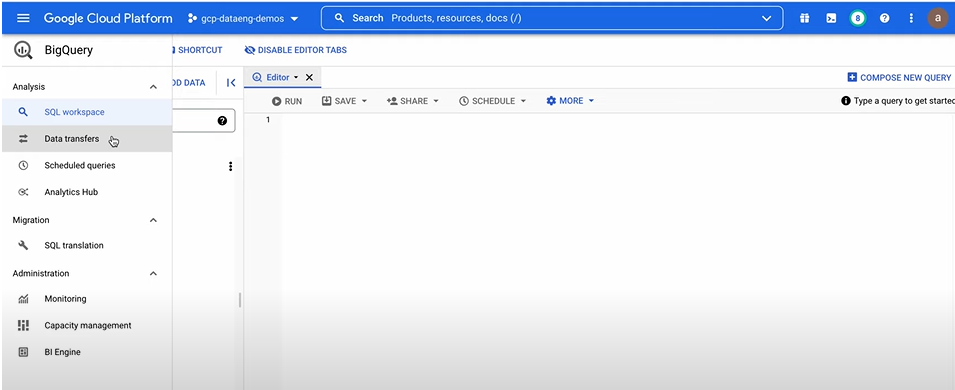
- Access the BigQuery Page: Navigate to the BigQuery section in the Google Cloud Console to manage your datasets and transfers.
- Locate the Transfers Option: In the BigQuery interface, look for the “Transfers” option in the left-side menu under the “Resources” section. This is where you configure data imports from external sources like Google Play Console.
- Prepare for Data Transfer Setup: Once you click “Transfers,” you’ll see an option to create a new transfer configuration. This is where you specify your source (Google Play Console) and define how often data should sync with BigQuery.
Step 3.5: Click on Create Transfer Under Data Transfer
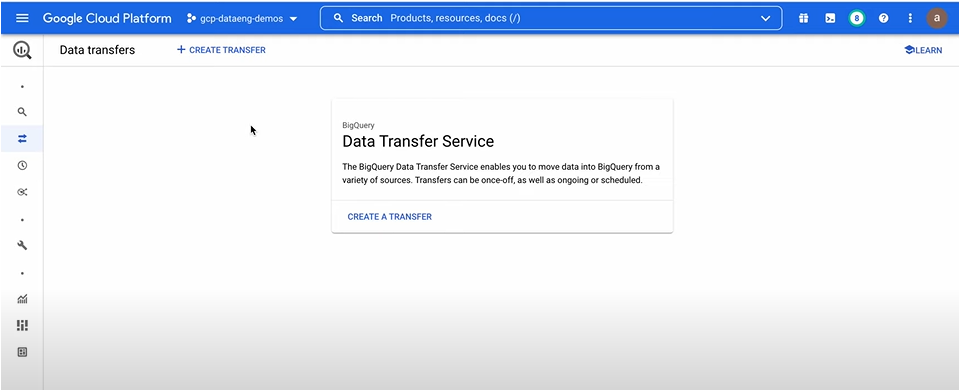
- Initiate the Transfer Setup: Click “Create Transfer” to open the configuration panel, where you’ll set up the connection between Google Play Console and BigQuery.
- Select Data Source: In the “Create Transfer” panel, choose Google Play Console as your data source. Provide your necessary details, like project and dataset, to ensure proper data mapping.
- Customize Transfer Settings: Define the frequency of data transfers (e.g., daily or weekly) and set notifications to alert you in case of failures or issues.
Step 3.6: Set the Source and Schedule Options.
- Select Google Play as the Source: In the source field, choose “Google Play Console” to define the data origin for the transfer.
- Configure the Transfer Schedule: Enter the schedule details under the Schedule tab. You can either select “Start Now” for immediate transfer or specify a custom start time.Step 6: Set the source and schedule options.
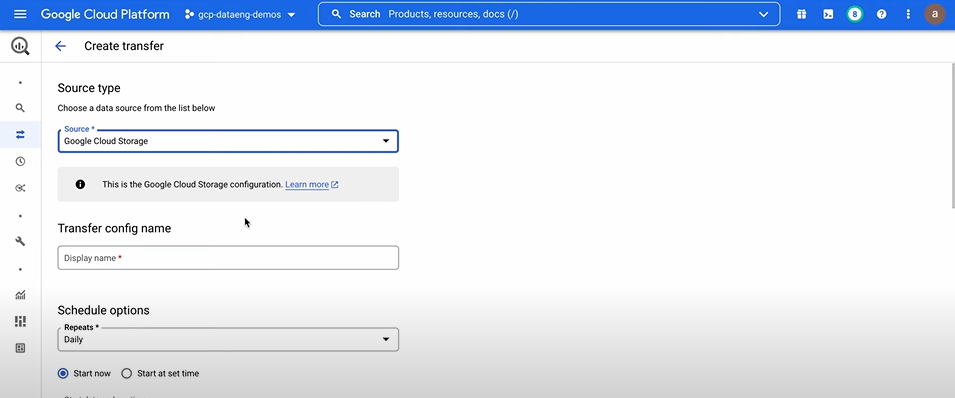
- Set Destination Settings: Pick the dataset you created earlier as the destination to store the imported Google Play Console data in BigQuery.
- Review and Finalize: Double-check the details and save the transfer configuration to initiate the data flow.
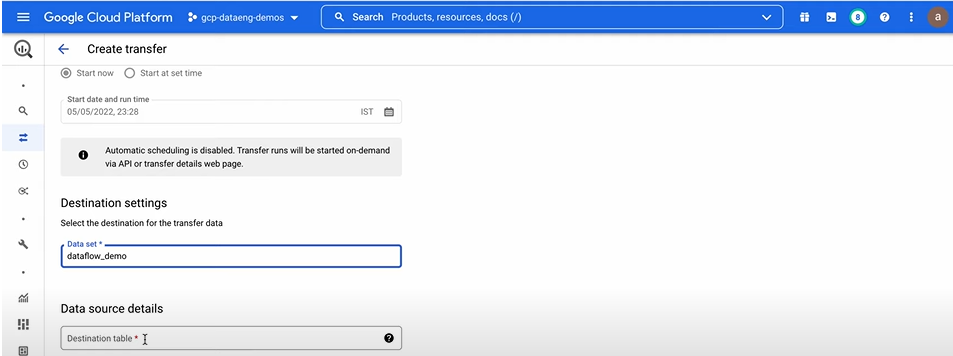
Step 3.7: Click Save
- The BigQuery Data Transfer Service will start to automatically move data from your Google Play Console at your scheduled time.
Why Connect Google Play Console to BigQuery?
Integrating Google Play Console with BigQuery offers both benefits and practical use cases for businesses and developers. Here’s why this integration is valuable:
Benefits:
- Centralized Data Management: Consolidate Google Play Console data with information from other tools like CRMs, payment gateways, and support platforms for a unified view.
- Scalable Analytics: Use BigQuery’s powerful analytics capabilities to process and analyze large volumes of app performance and user engagement data.
- Enhanced Decision-Making: Access detailed insights into app downloads, user demographics, and performance metrics to make data-driven decisions.
- Improved Customer Experience: Leverage data to refine app performance and address user needs effectively.
Use Cases:
- Marketing Analysis: Understand user acquisition trends and optimize marketing campaigns by analyzing install sources and regions.
- Performance Optimization: Monitor crash reports and app performance data to identify and fix issues quickly.
- Revenue Tracking: Analyze in-app purchases and subscription data to measure financial performance.
- Cross-Tool Insights: Combine app data with customer support, inventory, and other business data to deliver better user experiences and operational efficiency.
By connecting Google Play Console with BigQuery, businesses can harness the full potential of their app data to drive growth and enhance user satisfaction.
Conclusion
Integrating Google Play Console with BigQuery helps unlock valuable insights by centralizing app performance data for analysis. Whether you use automated pipelines, custom code, or BigQuery Data Transfer Service, each method ensures seamless data flow. Choose the approach that best suits your needs to optimize decision-making.
Hevo is the only real-time ELT no-code data pipeline platform that cost-effectively automates data pipelines that are flexible to your needs.
Want to take Hevo for a spin? Try for a 14-day free trial and experience the feature-rich Hevo suite firsthand. You can also have a look at the unbeatable pricing that will help you choose the right plan for your business needs.
FAQs
1. How do I migrate from Cloud SQL to BigQuery?
Export data from Cloud SQL to CSV or JSON and load it into BigQuery. With Hevo, you can automate the entire process, enabling real-time migration with no manual effort.
2. How can you access BigQuery using the console?
Log in to the Google Cloud Console, navigate to BigQuery, and use the SQL workspace for queries. Hevo can automatically load data into BigQuery for easy access.
3. What is the difference between Google Cloud Storage and BigQuery?
Google Cloud Storage is for storing unstructured data, while BigQuery is a data warehouse for running SQL queries on large datasets. Hevo can help move data between the two for analysis.






